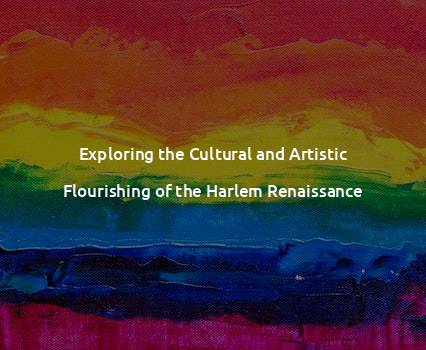Exploring the Cultural and Artistic Flourishing of the Harlem Renaissance
Exploring the Cultural and Artistic Flourishing of the Harlem Renaissance
The Harlem Renaissance was a pivotal period in American history during the 1920s and 1930s, characterized by a remarkable cultural and artistic flourishing within the African American community in Harlem, New York City. Often referred to as the “New Negro Movement,” this vibrant era birthed a renaissance that challenged societal norms, celebrated black identity, and left a lasting impact on the cultural landscape of America.
The Intellectual Awakening
The Harlem Renaissance marked a significant intellectual awakening among African Americans, with an unprecedented surge in literary, artistic, musical, and theatrical expressions. Emerging from a backdrop of racial segregation and discrimination, African American intellectuals sought to challenge and redefine the prevailing stereotypes through their creative works.
Prominent writers such as Langston Hughes, Zora Neale Hurston, and Claude McKay used their powerful voices to address social and racial issues, depicting the richness and complexity of black experiences. Through poetry, novels, and essays, they explored themes of racial identity, discrimination, and the struggle for equality, leaving an indelible mark on American literature.
The Harlem Renaissance in Art
The artistic movement of the Harlem Renaissance extended far beyond literature. Visual artists like Aaron Douglas, Palmer Hayden, and Augusta Savage created stunning artwork that depicted the beauty and challenges of African American life during that time. These artists drew inspiration from African cultures, ancient Egyptian art, and the contemporary realities of the black community.
Perhaps the most well-known artist of the era, Aaron Douglas, incorporated African motifs and bold geometric shapes into his paintings to represent the strength and resilience of African Americans. His artwork often celebrated black history, depicting scenes from African mythology and the struggles of the African diaspora.
The Rhythms of Music
At the center of the Harlem Renaissance was the explosion of jazz music, which embodied the vibrant and energetic spirit of the era. Jazz clubs like the Cotton Club and the Apollo Theater became cultural hotspots, attracting renowned musicians such as Duke Ellington, Louis Armstrong, and Billie Holiday.
Jazz music not only captivated audiences with its swing rhythms and improvisational nature but also served as a powerful expression of black identity. By merging African musical traditions with European harmonies, jazz musicians crafted a new sound that celebrated the resilience and creativity of African American culture.
The Theatrical Renaissance
The Harlem Renaissance was also a time of great experimentation and innovation in theater. Pioneering playwrights such as Langston Hughes and Zora Neale Hurston, along with the establishment of the Lafayette Players, worked to tell stories from an African American perspective.
They explored themes such as the impact of racism, struggles for economic independence, and the complexities of racial identity. These theatrical productions became platforms for African American actors to showcase their talents and challenge stereotypes prevalent in mainstream theater.
The Enduring Legacy
The Harlem Renaissance not only revolutionized the cultural landscape of America at the time, but its legacy continues to inspire and influence artists today. Its impact can be seen in the works of contemporary African American artists across various mediums, from literature to music to visual arts.
The Harlem Renaissance remains a testament to the power of art and culture in challenging societal norms and promoting social change. By creating a space where African Americans could freely express their creativity and assert their identity, the movement forever changed American art and helped pave the way for subsequent civil rights movements.
TL;DR
The Harlem Renaissance was a revolutionary period during the 1920s and 1930s, characterized by a vibrant cultural and artistic flourishing within the African American community in Harlem, New York City. Through literature, art, music, and theater, African American intellectuals challenged societal norms, celebrated black identity, and addressed social issues of the time. The movement left a lasting impact on American literature, visual arts, jazz music, and theater, and continues to inspire and influence artists to this day. The Harlem Renaissance stands as a powerful testament to the transformative power of art and culture in promoting social change and equality.







